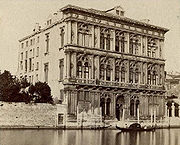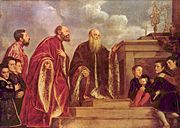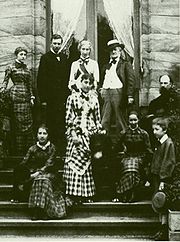
Ca' Vendramin Calergi
Encyclopedia
Ca' Vendramin Calergi is a palace on the Grand Canal in the sestiere
(quarter) of Cannaregio
in Venice
, northern Italy
. Other names by which it is known include: Palazzo Vendramin Calergi, Palazzo Loredan Vendramin Calergi, and Palazzo Loredan Griman Calergi Vendramin. The architecturally distinguished building was the home of many prominent people through history, and is remembered as the place where composer Richard Wagner
died.
Currently, it is home to the Venice Casino (Casinò di Venezia) and the Wagner Museum (Museo Wagner).
, architect of Chiesa di San Zaccaria and other noteworthy churches and private residences in Venice. Construction began in 1481 and was finished after his death by the Bottega dei Lombardo in 1509. The twenty-eight-year period it took to complete construction is considered short based on the technology available at that time.
 The spacious Renaissance-style
The spacious Renaissance-style
palace stands three-stories high with direct access to the Grand Canal available by gondola
s. The beauty and balance of the building's façade
are exceptional. Classically inspired columns divide each level facing the canal. Two pairs of tall French doors divided by a single column topped by arch
es and a trefoil
window rest above the doors on the piano nobile
and upper levels. Opulent paintings, sculptures, and architectural details originally filled the building's interior. Baroque master Mattia Bortoloni
decorated the ceilings of many rooms. The palace is locally known by the nickname "Non Nobis Domine" ("Not unto us, O Lord") from Psalm 113:9, which is engraved in the stone under a ground-floor window.
 Andrea Loredan
Andrea Loredan
, a connoisseur
of the fine arts, commissioned the palace, which was paid for by the doge
, Leonardo Loredan. In 1581, the Loredan family suffered financial difficulties and sold it for 50,000 ducat
s to Julius, Duke of Brunswick-Lüneburg
, who had deep affection for Venice. However, the duke kept it only two years before selling it to Guglielmo I Gonzaga, Marquis of Mantua
, who then sold it to Vittore Calergi, a Venetian noble from Heraklion
on the island of Crete
. Calergi greatly expanded the building in 1614 with a large addition by architect Vincenzo Scamozzi
called the "White Wing" which included windows overlooking a garden courtyard. (The addition was demolished in 1659 and rebuilt the following year.) In 1739, the palace was inherited through marriage by the Vendramin
s, a powerful patrician family of merchants, bankers, religious leaders, and politicians, who owned it for more than a century.
In 1844, Caroline Ferdinande of Bourbon-Two Sicilies, the Duchess of Berry, and her second husband, Ettore Carlo Lucchesi-Palli, Duke della Grazia, purchased Ca' Vendramin Calergi from the last member of the Vendramin family line. In the turmoil of the Risorgimento, they were forced to sell the palace to Caroline's grandson, Henry (Enrico), Count de' Bardi
, and many of its fine works of art were auctioned in Paris. Count de' Bardi and his wife Infanta Adelgundes
and the related Dukes of Grazia maintained the home and hosted many famous names of the day. In 1937, the last of the Grazia nobles, Count Lucchesi-Palli, sold it to Giovanni Volpi, Count of Misurata, who remodeled the living quarters and turned it into a Center for Electromagnetic and Electrical Phenomena.
The City Council of Venice purchased Ca' Vendramin Calergi in 1946. Since 1959, it has been the winter home to the celebrated Venice Casino (Casinò di Venezia).
 German composer Richard Wagner
German composer Richard Wagner
stayed in Venice six times between 1858 and his death. He arrived in Italy on his final trip not long after performances of his opera Parsifal
premiered at the second Bayreuth Festival
. He rented the entire piano nobile (mezzanine) level of the Ca' Vendramin Calergi from Count de' Bardi
before his departure and arrived on 16 September 1882 with his wife Cosima Liszt, four children (Daniela von Bülow, Isolde, Eva and Siegfried Wagner
) and household servants.
Wagner died of a heart attack in the palace on 13 February 1883 at age 69. A memorial plaque on a brick wall adjacent to the building is inscribed with a tribute by novelist and poet Gabriele d'Annunzio
that reads:
The Wagner Museum (Museo Wagner) opened at the palace in February 1995. It holds the Josef Lienhart Collection of rare documents, musical scores, signed letters, paintings, records, and other heirlooms. The holdings constitute the largest private collection dedicated to Wagner outside of Bayreuth. The museum is open to the public on Saturday mornings by appointment.
The Associazione Richard Wagner di Venezia operates the museum and the Richard Wagner European Study and Research Center (Centro Europeo di Studi e Richerche Richard Wagner - C.E.S.R.R.W.). It also holds exhibitions, conferences, and concerts, and publishes scholarly papers that promote the life and works of Wagner.
The International Association of Wagner Societies also holds a symposium called "Wagner Days in Venice" (Giornate Wagneriane a Venezia) at the palace each autumn.
Sestiere
A sestiere is a subdivision of certain Italian towns and cities. The word is from sesto, or sixth; and is thus used only for towns divided into six districts. The best-known example are the sestieri of Venice, but Ascoli Piceno, Genoa, Milan and Rapallo, for example, were also divided into sestieri...
(quarter) of Cannaregio
Cannaregio
Cannaregio is the northernmost of the six historic sestieri of Venice. It is the second largest sestiere by land area and the largest by population, with 13,169 people as of 2007....
in Venice
Venice
Venice is a city in northern Italy which is renowned for the beauty of its setting, its architecture and its artworks. It is the capital of the Veneto region...
, northern Italy
Italy
Italy , officially the Italian Republic languages]] under the European Charter for Regional or Minority Languages. In each of these, Italy's official name is as follows:;;;;;;;;), is a unitary parliamentary republic in South-Central Europe. To the north it borders France, Switzerland, Austria and...
. Other names by which it is known include: Palazzo Vendramin Calergi, Palazzo Loredan Vendramin Calergi, and Palazzo Loredan Griman Calergi Vendramin. The architecturally distinguished building was the home of many prominent people through history, and is remembered as the place where composer Richard Wagner
Richard Wagner
Wilhelm Richard Wagner was a German composer, conductor, theatre director, philosopher, music theorist, poet, essayist and writer primarily known for his operas...
died.
Currently, it is home to the Venice Casino (Casinò di Venezia) and the Wagner Museum (Museo Wagner).
History
Ca' Vendramin Calergi was designed in the late 15th century by Mauro CodussiMauro Codussi
Mauro Codussi was an Italian architect of the early-Renaissance, active mostly in Venice. The name can also be spelt Coducci. He was one of the first to bring the classical syle of the early renaissance to Venice to replace the prevalent Gothic style.Born near Bergamo about 1440, he is first...
, architect of Chiesa di San Zaccaria and other noteworthy churches and private residences in Venice. Construction began in 1481 and was finished after his death by the Bottega dei Lombardo in 1509. The twenty-eight-year period it took to complete construction is considered short based on the technology available at that time.

Renaissance architecture
Renaissance architecture is the architecture of the period between the early 15th and early 17th centuries in different regions of Europe, demonstrating a conscious revival and development of certain elements of ancient Greek and Roman thought and material culture. Stylistically, Renaissance...
palace stands three-stories high with direct access to the Grand Canal available by gondola
Gondola
The gondola is a traditional, flat-bottomed Venetian rowing boat, well suited to the conditions of the Venetian Lagoon. For centuries gondolas were the chief means of transportation and most common watercraft within Venice. In modern times the iconic boats still have a role in public transport in...
s. The beauty and balance of the building's façade
Facade
A facade or façade is generally one exterior side of a building, usually, but not always, the front. The word comes from the French language, literally meaning "frontage" or "face"....
are exceptional. Classically inspired columns divide each level facing the canal. Two pairs of tall French doors divided by a single column topped by arch
Arch
An arch is a structure that spans a space and supports a load. Arches appeared as early as the 2nd millennium BC in Mesopotamian brick architecture and their systematic use started with the Ancient Romans who were the first to apply the technique to a wide range of structures.-Technical aspects:The...
es and a trefoil
Trefoil
Trefoil is a graphic form composed of the outline of three overlapping rings used in architecture and Christian symbolism...
window rest above the doors on the piano nobile
Piano nobile
The piano nobile is the principal floor of a large house, usually built in one of the styles of classical renaissance architecture...
and upper levels. Opulent paintings, sculptures, and architectural details originally filled the building's interior. Baroque master Mattia Bortoloni
Mattia Bortoloni
Mattia Bortoloni was an Italian painter of the Rococo period, mainly active in the area of Bergamo and Venice.Born in Canda, near Rovigo, he died in Bergamo. He trained with Antonio Balestra of Verona. Bortoloni painted the 104-panel fresco cycle at Villa Cornaro, a Palladian villa in Piombino...
decorated the ceilings of many rooms. The palace is locally known by the nickname "Non Nobis Domine" ("Not unto us, O Lord") from Psalm 113:9, which is engraved in the stone under a ground-floor window.

Loredan
The family of Loredan were a noble family of the Republic of Venice. The family contributed three Doges: Leonardo Loredan , Pietro Loredan , and Francesco Loredan , of whom only the first truly set his mark on the history of Venice; the Portrait of Doge Leonardo Loredan by Giovanni Bellini makes...
, a connoisseur
Connoisseur
A connoisseur is a person who has a great deal of knowledge about the fine arts, cuisines, or an expert judge in matters of taste.Modern connoisseurship must be seen along with museums, art galleries and "the cult of originality"...
of the fine arts, commissioned the palace, which was paid for by the doge
Doge
Doge is a dialectal Italian word that descends from the Latin dux , meaning "leader", especially in a military context. The wife of a Doge is styled a Dogaressa....
, Leonardo Loredan. In 1581, the Loredan family suffered financial difficulties and sold it for 50,000 ducat
Ducat
The ducat is a gold coin that was used as a trade coin throughout Europe before World War I. Its weight is 3.4909 grams of .986 gold, which is 0.1107 troy ounce, actual gold weight...
s to Julius, Duke of Brunswick-Lüneburg
Julius, Duke of Brunswick-Lüneburg
Julius of Brunswick-Lüneburg , Duke of Brunswick-Lüneburg, was prince of Wolfenbüttel from 1568 until his death....
, who had deep affection for Venice. However, the duke kept it only two years before selling it to Guglielmo I Gonzaga, Marquis of Mantua
Duchy of Mantua
The Duchy of Mantua was a duchy in Lombardy, Northern Italy, subject to the Holy Roman Empire.-History:After the fall of the Western Roman Empire, Mantua was invaded by Byzantines, Longobards and Franks. In the 11th century it became a possession of Boniface of Canossa, marquis of Toscana...
, who then sold it to Vittore Calergi, a Venetian noble from Heraklion
Heraklion
Heraklion, or Heraclion is the largest city and the administrative capital of the island of Crete, Greece. It is the 4th largest city in Greece....
on the island of Crete
Crete
Crete is the largest and most populous of the Greek islands, the fifth largest island in the Mediterranean Sea, and one of the thirteen administrative regions of Greece. It forms a significant part of the economy and cultural heritage of Greece while retaining its own local cultural traits...
. Calergi greatly expanded the building in 1614 with a large addition by architect Vincenzo Scamozzi
Vincenzo Scamozzi
thumb|250px|Portrait of Vincenzo Scamozzi by [[Paolo Veronese]]Vincenzo Scamozzi was a Venetian architect and a writer on architecture, active mainly in Vicenza and Republic of Venice area in the second half of the 16th century...
called the "White Wing" which included windows overlooking a garden courtyard. (The addition was demolished in 1659 and rebuilt the following year.) In 1739, the palace was inherited through marriage by the Vendramin
Vendramin
The Vendramin were a rich merchant family of Venice, Italy, who were among the case nuove or "new houses" who joined the patrician class when the Libro d'Oro was opened after the battle of Chioggia...
s, a powerful patrician family of merchants, bankers, religious leaders, and politicians, who owned it for more than a century.
In 1844, Caroline Ferdinande of Bourbon-Two Sicilies, the Duchess of Berry, and her second husband, Ettore Carlo Lucchesi-Palli, Duke della Grazia, purchased Ca' Vendramin Calergi from the last member of the Vendramin family line. In the turmoil of the Risorgimento, they were forced to sell the palace to Caroline's grandson, Henry (Enrico), Count de' Bardi
Prince Henry, Count of Bardi
Prince Henry of Bourbon-Parma, Count of Bardi was the youngest son and child of Charles III, Duke of Parma and his wife Princess Louise Marie Thérèse of France, the eldest daughter of Charles Ferdinand, Duke of Berry and Princess Caroline Ferdinande Louise of the Two Sicilies.Henry was thus a...
, and many of its fine works of art were auctioned in Paris. Count de' Bardi and his wife Infanta Adelgundes
Infanta Adelgundes, Duchess of Guimarães
Infanta Adelgundes of Portugal, Duchess of Guimarães was the fifth child and fourth daughter of Miguel of Portugal and his wife Adelaide of Löwenstein-Wertheim-Rosenberg. A member of the House of Braganza by birth, Adelgundes became a member of the House of Bourbon-Parma through her marriage to...
and the related Dukes of Grazia maintained the home and hosted many famous names of the day. In 1937, the last of the Grazia nobles, Count Lucchesi-Palli, sold it to Giovanni Volpi, Count of Misurata, who remodeled the living quarters and turned it into a Center for Electromagnetic and Electrical Phenomena.
The City Council of Venice purchased Ca' Vendramin Calergi in 1946. Since 1959, it has been the winter home to the celebrated Venice Casino (Casinò di Venezia).
Wagner Museum

Richard Wagner
Wilhelm Richard Wagner was a German composer, conductor, theatre director, philosopher, music theorist, poet, essayist and writer primarily known for his operas...
stayed in Venice six times between 1858 and his death. He arrived in Italy on his final trip not long after performances of his opera Parsifal
Parsifal
Parsifal is an opera in three acts by Richard Wagner. It is loosely based on Wolfram von Eschenbach's Parzival, the 13th century epic poem of the Arthurian knight Parzival and his quest for the Holy Grail, and on Chrétien de Troyes' Perceval, the Story of the Grail.Wagner first conceived the work...
premiered at the second Bayreuth Festival
Bayreuth Festival
The Bayreuth Festival is a music festival held annually in Bayreuth, Germany, at which performances of operas by the 19th century German composer Richard Wagner are presented...
. He rented the entire piano nobile (mezzanine) level of the Ca' Vendramin Calergi from Count de' Bardi
Prince Henry, Count of Bardi
Prince Henry of Bourbon-Parma, Count of Bardi was the youngest son and child of Charles III, Duke of Parma and his wife Princess Louise Marie Thérèse of France, the eldest daughter of Charles Ferdinand, Duke of Berry and Princess Caroline Ferdinande Louise of the Two Sicilies.Henry was thus a...
before his departure and arrived on 16 September 1882 with his wife Cosima Liszt, four children (Daniela von Bülow, Isolde, Eva and Siegfried Wagner
Siegfried Wagner
Siegfried Wagner was a German composer and conductor, the son of Richard Wagner. He was an opera composer and the artistic director of the Bayreuth Festival from 1908 to 1930.-Life:...
) and household servants.
Wagner died of a heart attack in the palace on 13 February 1883 at age 69. A memorial plaque on a brick wall adjacent to the building is inscribed with a tribute by novelist and poet Gabriele d'Annunzio
Gabriele D'Annunzio
Gabriele D'Annunzio or d'Annunzio was an Italian poet, journalist, novelist, and dramatist...
that reads:
- In questo palagio / l'ultimo spiro di Riccardo Wagner / odono le anime perpetuarsi come la marea / che lambe i marmi
The Wagner Museum (Museo Wagner) opened at the palace in February 1995. It holds the Josef Lienhart Collection of rare documents, musical scores, signed letters, paintings, records, and other heirlooms. The holdings constitute the largest private collection dedicated to Wagner outside of Bayreuth. The museum is open to the public on Saturday mornings by appointment.
The Associazione Richard Wagner di Venezia operates the museum and the Richard Wagner European Study and Research Center (Centro Europeo di Studi e Richerche Richard Wagner - C.E.S.R.R.W.). It also holds exhibitions, conferences, and concerts, and publishes scholarly papers that promote the life and works of Wagner.
The International Association of Wagner Societies also holds a symposium called "Wagner Days in Venice" (Giornate Wagneriane a Venezia) at the palace each autumn.
External links
- Ca' Vendramin Calergi: History, photographs, and a virtual tour
- Casinò di Venezia / Venice Casino: Casino and hospitality
- Wagner Museum

